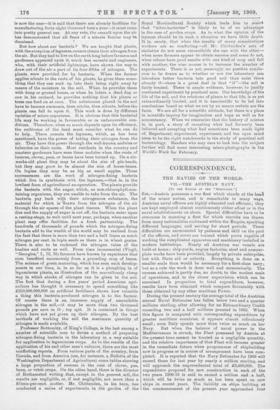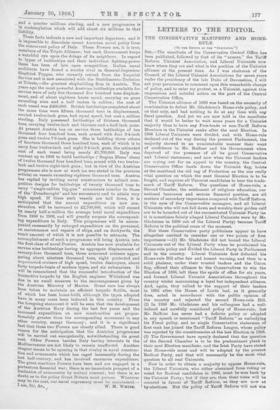CORRESPONDENCE.
[TO THE EDITOR OF THE " SPECTATOR." .1
Sin,—Austria possesses a war fleet which stands at the leaa of the minor navies, and is remarkable in many ways. Austrian naval officers are highly educated and efficient; they are kept employed almost continuously either afloat or in the naval establishments on shore. Special difficulties have to be overcome in manning a fleet for which recruits are drawn from many nationalities embraced within the Empire, speaking different languages, and serving for short periods. These difficulties are surmounted by patience and skill on the part of the officers, and crews are trained which prove capable of working the complicated apparatus and machinery installed in modern battleships. Nearly all Austrian war vessels are built at home ; ship-yards, engine factories, steel and armour- plate works have been provided, largely by private enterprise, but with State aid or subsidy. Everything is done on a smaller scale than would be necessary for a first-class navy; but as a rule the work is done well and economically. The success achieved is partly due, no doubt, to the modest scale of operations, and to the closer supervision which can be exercised. In proportion to total expenditure, however, results have been obtained which compare favourably with those obtained by any other maritime Power.
During the present century the average total of the Austrian annual Naval Estimates has fallen below two and a quarter millions sterling, after allowing for an Extraordinary Credit exceeding two and a half millions granted in 1905. When this figure is compared with corresponding expenditure by greater maritime countries, it appears almost ridiculously small; even Italy spends more than twice as, much on her Navy. But when the balance of naval power in the Mediterranean is struck, the Fleet possessed by Austria at the present time cannot be treated as a negligible quantity, and the relative importance of that Fleet will become greater in the immediate future when programmes of shipbuilding now in progress or in course of arrangement have been com- pleted. It is reported that the Navy Estimates fer 1909 will exceed those for last year by nearly a million sterling, and will .approach the unprecedented total of £3,400,000. The expenditure proposed for new construction in each of the two years 1909710 is said to, exceed a million and a half, which will be twice as much as has been spent on new ships in recent years. The liability on ships banding at the commencement of the present year approached four
and a quarter millions sterling, and a new programme is in contemplation which will add about six millions to that liability.
These facts indicate a new and important departure ; and it ie impossible to dissociate recent Austrian naval policy from the concurrent policy of Italy. These Powers are, it is true, members of the Triple Alliance; but each Government keeps a watchful eye upon the doings of its neighbour. In regard to types of battleships and their individual fighting-power there has been of late open competition. Italian naval architects have found a worthy rival in General-Ingenieur Siegfried Popper, -who recently retired from the Imperial Service and is now associated with the Stabilimento-Technico at Trieste,—the greatest shipbuilding firm in Austria. Ten years ago the most powerful Austrian battleships available for service were of only five thousand five hundred tons displace- ment, and of about eighteen knots speed, carrying no guns exceeding nine and a half inches in calibre ; the cost of each vessel was 2400,000. British battleships completed about the same time were fifteen thousand tons in displacement, carried twelve-inch guns, had equal speed, but cost a million sterling. Italy possessed battleships of thirteen thousand tons, carrying twelve-inch and thirteen-and-a-half-inch guns. At present Austria has on service three battleships of ten thousand four hundred tons, each armed with four 94-inch guns and twelve 7.6-inch guns. She is building three others of fourteen thousand three hundred tons, each of which is to carry four twelve-inch and eight 9.4-inch guns, the estimated cost of each vessel being nearly 21,700,000. Italy was content up to 1908 to build battleships (' Regina Elena' class) of twelve thousand four hundred tons, armed with two twelve- inch and twelve eight-inch guns ; but in view of the Austrian Programme she is now at work (as was stated in the previous article) on vessels exceeding eighteen thousand tons. Austria has replied by inviting naval constructors to submit com- petitive designs for battleships of twenty thousand tons to carry "single-calibre big-gun" armaments (similar to those of the 'Dreadnought' and her successors) and to attain very high speed. If three such vessels are laid down, it is anticipated that the annual expenditure on new con- struction will be increased to 22,700,000, which will exceed by nearly half-a-million the average total naval expenditure from 1900 to 1908, and will greatly surpass the correspond- ing expenditure in Italy. This programme will be accom- panied necessarily by enlarged expenditure on the personnel, on maintenance and repairs of ships, and on dockyards, the exact amount of which it is not possible to estimate. The accomplishment of such a programme will bring Austria into the first class of naval Powers. Austria has now available for service nine battleships having an aggregate displacement of Beventy-four thousand tons, three armoured cruisers aggre- gating about nineteen thousand tons, eight protected and unprotected cruisers of high speed, twelve destroyers, about forty torpedo-boats of modern types, and six submarines. It will be remembered that the successful introduction of the locomotive torpedo by the English engineer Whitehead was due in no small measure to the encouragement given by the Austrian Ministry of Marine. Great care has always been taken to maintain an efficient torpedo flotilla, most of which has been home-built, although the types adopted have in many cases been initiated in this country. From the foregoing statement it will be seen that the development of the Austrian Navy during the last few years and the increased expenditure on new construction are propor- tionately greater than the corresponding movement in any Other country, except Germany ; and it is a significant fact that these two Powers are closely allied. There is good reason for' the anticipation that the Austrian programme win be carried out energetically, notwithstanding its great cost. Other Powers besides Italy having interests in the Mediterranean are not likely to remain unaffected. Another chapter seems to be opening in that rivalry in naval construc- tion and armaments which has raged incessantly during the last half-century, and has involved enormous expenditure. The great maritime Powers have been and are engaged in a Portentous financial war; there is no immediate prospect of a limitation of armaments by mutual consent; but there is no doubt as to the policy Great Britain must pursue. Whatever may be the cost, our naval supremacy must be maintained.—

























































 Previous page
Previous page